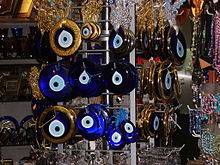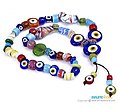| Revision as of 14:38, 13 November 2007 editXia (talk | contribs)Extended confirmed users, Pending changes reviewers14,838 editsm hu interwiki← Previous edit | Latest revision as of 14:49, 5 January 2025 edit undo2a02:1406:45:a1bc:ac97:dc37:3760:937f (talk)No edit summaryTags: Mobile edit Mobile web edit | ||
| (666 intermediate revisions by more than 100 users not shown) | |||
| Line 1: | Line 1: | ||
| {{short description|Eye-shaped amulet believed to protect against the evil eye}} | |||
| ] | |||
| ] | |||
| A '''nazar''' or '''evil eye stone''' (]: ''nazar boncuğu'') is an ] from ancient mythology that protects against the ]. | |||
| ] – for sale in a shop.]] | |||
| An '''eye bead''' or '''naẓar''' (from ] {{wikt-lang|ar|نَظَر}} {{IPA|ar|ˈnaðˤar|}}, meaning 'sight', 'surveillance', 'attention', and other related concepts) is an eye-shaped ] believed by many to protect against the ]. The term is also used in ], ], ], ], ], ], ], ], ], ] and other languages.<ref name="Khan2006">{{cite book|last=Khan|first=Abdul Jamil|title=Urdu/Hindi: An Artificial Divide: African Heritage, Mesopotamian Roots, Indian Culture & British Colonialism|year=2006 |publisher=Algora Publishing |language=en|isbn=9780875864389|page=138|quote=Arabic verbs have generated an enormous number of words for Urdu/Hindi as well as Persian. ... The word ''nazar'', meaning eye, or sight, is part of the cultural idiom -- <nazar lag jana>, meaning 'evil eye's effect,' and is used in the whole subcontinent.}}</ref> In Turkey, it is known by the name '''{{transl|tr|nazar boncuğu}}'''<ref name="Williams">Williams, Victoria (2016). ''Celebrating Life Customs Around the World: From Baby Showers to Funerlan'', p.344. ABC-CLIO. {{ISBN|9781440836596}}. "nazar boncugu".</ref> (the latter word being a derivative of {{lang|tr|boncuk}}, "bead" in Turkic, and the former borrowed from Arabic), in Greece it is known as '''{{transl|el|máti}}''' ({{wikt-lang|el|μάτι}}, 'eye'). In ], it is called a '''{{transl|fa|cheshm nazar}}''' ({{langx|fa|چشم نظر}}) or '''{{transl|fa|nazar qurbāni}}''' ({{lang|fa|نظرقربانی}}).<ref>M. Moin: ''A Persian Dictionary, 3rd edition'', p. 4752 (in Persian).</ref> In India and Pakistan, the Hindi-Urdu slogan '']'' ({{wikt-lang|fa|چشم بدور}}, ' eye keep away') is used to ward off the evil eye.<ref>{{cite book|title=South Asian Cinema, Volume 1, Issue 1|url=https://books.google.com/books?id=0eVkAAAAMAAJ|year=2001|publisher=South Asian Cinema Foundation|language=en|page=61}}</ref> In the Indian subcontinent, the phrase ''nazar lag gai'' is used to indicate that one has been affected by the evil eye.<ref>{{cite journal|author1=Mehmet Kaan Kaya, Arun D Singh, Harminder S Dua|date=22 May 2009|title=Nazar boncugu—blue glass Evil Eye bead|url=https://bjo.bmj.com/content/93/6/707|journal=]|language=en|volume=93|issue=707|access-date=13 May 2019|quote=The phrases “Nazar lag gai” (affected by the Evil Eye) and “Nazar utarna” (removing the effects of Evil Eye) are common in Hindu culture.}}</ref><ref>Fallon, S.W. (1879). '''', p.1164. Lazarus. {{pre-ISBN}}. "''nazar lagānā'', v. a. To cast an evil eye upon; to regard with evil intent. [by an evil eye.<br/>''nazar lagnā, yā khānā'', v. n. To be influenced"</ref><ref>Clark-Decès, Isabelle; ed. (2011). ''A Companion to the Anthropology of India'', p.228. Wiley. {{ISBN|9781405198929}}. "nazar lagana".</ref> | |||
| The nazar was added to ] as {{unichar|1F9FF|Nazar Amulet}} in 2018.<ref>{{cite web|url=https://emojipedia.org/nazar-amulet/|title=🧿 Nazar Amulet Emoji|website=]}}</ref> | |||
| It consists of concentric circles (from inside out: dark blue, light blue (or yellow), white, dark blue). Therefore it is sometimes called '''"Blue Eye"'''. | |||
| ==Amulet== | |||
| "In a shortened version we will try to explain. Once upon a time (yes, it starts like in a fairy tale) there was a rock by the sea that, even with the force of a hundred men and a lot of dynamite, couldn't be moved or cracked. There was also a man in this town by the sea, who was known to carry the evil eye (Nazar). After much effort and endeavor, the town people brought the man to the rock, and the man, upon looking at the rock said, "My! What a big rock this is." The instant he said this, there was a rip and roar and crack and instantly the immense and impossible rock was found to be cracked in two. | |||
| A typical nazar is made of handmade glass featuring concentric circles or teardrop shapes in dark blue, white, light blue and black, occasionally with a yellow/gold edge.<ref name="LonelyPlanet">''Lonely Planet Middle East. ''Lonely Planet; 6 edition, 2009, p. 559.</ref> "The bead is made of a mixture of molten ], ], ], ], and ], ingredients that are thought to shield people from evil."<ref name="Williams"/> | |||
| The force of the evil eye (or Nazar) is a widely accepted and feared random element in Turkish daily life. The word *Nazar* denotes seeing or looking and is often used in literally translated phrases such as "Nazar touched her," in reference to a young woman, for example, who mysteriously goes blind. | |||
| "According to Turkish belief, blue acts as a shield against evil and even absorbs negativity."<ref name="Williams"/> In the Middle East and the Mediterranean,<ref>Sinclair, H. R. (2022). ''''. H. R. Sinclair.</ref><ref>Yablon, Alys R. (2015). ''''. Quirk Books. {{ISBN|9781594748363}}.</ref><ref>Martinson, Barbara; DeLong, Marilyn; eds. (2012). ''''. Bloomsbury. {{ISBN|9781847889539}}.</ref><ref>Darke, Diana (2014). '''', p.31. Bradt Travel Guides. {{ISBN|9781841624907}}. The evil eye, "generally takes the form of a blue-eye, because foreigners, were more likely to have blue eyes, were also more likely to stare, thereby unwittingly contravening local convention, and, by admiring the children or possessions of their hosts, accidentally casting the evil eye upon them."</ref> "blue eyes are relatively rare, so the ancients believed that people with light eyes, particularly blue eyes, could curse you with just one look. This belief is so ancient, even the ]ns had turquoise and blue-eye amulets."<ref>Lynn, Heather (2019). ''Evil Archaeology'', p.167. Red Wheel Weiser. {{ISBN|9781633411272}}.</ref> | |||
| Another typical scenario. A woman gives birth to a healthy child with pink cheeks, all the neighbors come and see the baby. They shower the baby with compliments, commentating especially on how healthy and chubby the baby is. After getting so much attention weeks later the baby is found dead in his crib. No explanation can be found for the death. It is ascribed to Nazar. Compliments made to a specific body part can result in Nazar. That's why nearly every Turkish mother fixes with a safety pin a small Boncuk on the child's clothes. Once a Boncuk is found cracked, it means it has done his job and immediately a new one has to replace it." | |||
| == |
== Eye bead == | ||
| ] | |||
| * | |||
| The Turkish {{lang | tr | boncuk}} (sometimes called a {{lang | tr | göz boncuğu}} or '''eye bead''') is a glass bead characterized by a blue glass field with a blue white and black dot superimposed on a white or yellow center. A design of great antiquity, the blue bead has gained importance as an item of popular ] in modern Turkey. The bead probably{{original research inline|date=July 2024}} originated in the ] and is associated{{citation needed|date=July 2024}} with the ]. Written documentation and extant beads date from as early as the 16th century BC. Glass beads were made and widely used throughout the ancient world: from ] to ], from ] to ancient ], from ] to ], and throughout the ].{{Citation needed|date=September 2022}} | |||
| ] | |||
| "The mythology behind it says that if one of the beads breaks down, it means a very strong ''nazar'' has hit you, and the bead stored it all up and broke down in order to protect the carrying person."<ref> | |||
| TurkishClass101.com (2017) ''''. Innovative Language Learning.</ref> | |||
| == Gallery == | |||
| ⚫ | ] | ||
| <gallery> | |||
| ⚫ | ] | ||
| File:Nazar Amulet in Turkey.jpg|Nazar Amulet | |||
| ⚫ | ] | ||
| File:Evil Eye Beads.jpg|Turkish Nazar Eye Beads | |||
| File:Nazar.jpg|Nazar-inspired sculpture in the ]. | |||
| File:Evil eye.jpg|Nazar evil eye charms. | |||
| File:Cheshm-Nazar.JPG|A Persian ''cheshm nazar''. | |||
| File:Nazar on the door.jpg|Nazar on a newborn baby's hospital room door in ]. | |||
| File:Jewish Amulets.jpg|A selection of Jewish amulets, an ''ayin mazal'' is visible next to the ]. | |||
| </gallery> | |||
| == See also == | |||
| ⚫ | ] | ||
| * ] | |||
| ] | |||
| ] | * ] | ||
| ] | * ] | ||
| * ] | |||
| ] | |||
| * ] | |||
| * ] | |||
| * ] | |||
| * ] | |||
| ⚫ | * ] | ||
| * ] | |||
| * ] | |||
| * ] | |||
| == References == | |||
| {{reflist}} | |||
| ==Sources== | |||
| * {{cite book|author=Ronald T. Marchese|date=2005|title=The Fabric of Life: Cultural Transformations in Turkish Society|url=https://books.google.com/books?isbn=1586842560|pages=103–107}} | |||
| ==External links== | |||
| * {{commons category-inline|Nazar amulets}} | |||
| * {{cite web |title=Nazar Amulet – Blue Color Wards Off The Evil Eye According To Ancient Belief |url=http://www.ancientpages.com/2018/03/13/nazar-amulet-blue-color-wards-off-the-evil-eye-according-to-ancient-belief/ |website=Ancient Pages |access-date=13 July 2021 |date=12 March 2018}} | |||
| {{Amulets and Talismans}} | |||
| {{Superstitions}} | |||
| ⚫ | ] | ||
| ] | |||
| ⚫ | ] | ||
| ] | |||
| ] | |||
| ] | |||
| ] | |||
| ⚫ | ] | ||
| ] | |||
Latest revision as of 14:49, 5 January 2025
Eye-shaped amulet believed to protect against the evil eye

An eye bead or naẓar (from Arabic نَظَر [ˈnaðˤar], meaning 'sight', 'surveillance', 'attention', and other related concepts) is an eye-shaped amulet believed by many to protect against the evil eye. The term is also used in Azerbaijani, Bengali, Hebrew, Hindi–Urdu, Kurdish, Pashto, Persian, Punjabi, Turkish, Greek and other languages. In Turkey, it is known by the name nazar boncuğu (the latter word being a derivative of boncuk, "bead" in Turkic, and the former borrowed from Arabic), in Greece it is known as máti (μάτι, 'eye'). In Persian and Afghan folklore, it is called a cheshm nazar (Persian: چشم نظر) or nazar qurbāni (نظرقربانی). In India and Pakistan, the Hindi-Urdu slogan chashm-e-baddoor (چشم بدور, ' eye keep away') is used to ward off the evil eye. In the Indian subcontinent, the phrase nazar lag gai is used to indicate that one has been affected by the evil eye.
The nazar was added to Unicode as U+1F9FF 🧿 NAZAR AMULET in 2018.
Amulet
A typical nazar is made of handmade glass featuring concentric circles or teardrop shapes in dark blue, white, light blue and black, occasionally with a yellow/gold edge. "The bead is made of a mixture of molten glass, iron, copper, water, and salt, ingredients that are thought to shield people from evil."
"According to Turkish belief, blue acts as a shield against evil and even absorbs negativity." In the Middle East and the Mediterranean, "blue eyes are relatively rare, so the ancients believed that people with light eyes, particularly blue eyes, could curse you with just one look. This belief is so ancient, even the Assyrians had turquoise and blue-eye amulets."
Eye bead

The Turkish boncuk (sometimes called a göz boncuğu or eye bead) is a glass bead characterized by a blue glass field with a blue white and black dot superimposed on a white or yellow center. A design of great antiquity, the blue bead has gained importance as an item of popular culture in modern Turkey. The bead probably originated in the Mediterranean and is associated with the development of glass-making. Written documentation and extant beads date from as early as the 16th century BC. Glass beads were made and widely used throughout the ancient world: from Mesopotamia to Egypt, from Carthage to ancient Greece, from Phoenicia to Persia, and throughout the Roman imperial period.

"The mythology behind it says that if one of the beads breaks down, it means a very strong nazar has hit you, and the bead stored it all up and broke down in order to protect the carrying person."
Gallery
-
 Nazar Amulet
Nazar Amulet
-
 Turkish Nazar Eye Beads
Turkish Nazar Eye Beads
-
 Nazar-inspired sculpture in the Netherlands.
Nazar-inspired sculpture in the Netherlands.
-
 Nazar evil eye charms.
Nazar evil eye charms.
-
A Persian cheshm nazar.
-
 Nazar on a newborn baby's hospital room door in Turkey.
Nazar on a newborn baby's hospital room door in Turkey.
-
 A selection of Jewish amulets, an ayin mazal is visible next to the hamsa.
A selection of Jewish amulets, an ayin mazal is visible next to the hamsa.
See also
- Eye of Providence
- God's eye
- Evil eye
- Darśana
- Eyespot (mimicry)
- Görece, Menderes
- Hamsa
- Namkha
- Nazar battu
- Mezuzah
- Skandola
- Ta'wiz
References
- Khan, Abdul Jamil (2006). Urdu/Hindi: An Artificial Divide: African Heritage, Mesopotamian Roots, Indian Culture & British Colonialism. Algora Publishing. p. 138. ISBN 9780875864389.
Arabic verbs have generated an enormous number of words for Urdu/Hindi as well as Persian. ... The word nazar, meaning eye, or sight, is part of the cultural idiom -- <nazar lag jana>, meaning 'evil eye's effect,' and is used in the whole subcontinent.
- ^ Williams, Victoria (2016). Celebrating Life Customs Around the World: From Baby Showers to Funerlan, p.344. ABC-CLIO. ISBN 9781440836596. "nazar boncugu".
- M. Moin: A Persian Dictionary, 3rd edition, p. 4752 (in Persian).
- South Asian Cinema, Volume 1, Issue 1. South Asian Cinema Foundation. 2001. p. 61.
- Mehmet Kaan Kaya, Arun D Singh, Harminder S Dua (22 May 2009). "Nazar boncugu—blue glass Evil Eye bead". British Journal of Ophthalmology. 93 (707). Retrieved 13 May 2019.
The phrases "Nazar lag gai" (affected by the Evil Eye) and "Nazar utarna" (removing the effects of Evil Eye) are common in Hindu culture.
{{cite journal}}: CS1 maint: multiple names: authors list (link) - Fallon, S.W. (1879). A New Hindustani-English Dictionary, p.1164. Lazarus. . "nazar lagānā, v. a. To cast an evil eye upon; to regard with evil intent. [by an evil eye.
nazar lagnā, yā khānā, v. n. To be influenced" - Clark-Decès, Isabelle; ed. (2011). A Companion to the Anthropology of India, p.228. Wiley. ISBN 9781405198929. "nazar lagana".
- "🧿 Nazar Amulet Emoji". Emojipedia.
- Lonely Planet Middle East. Lonely Planet; 6 edition, 2009, p. 559.
- Sinclair, H. R. (2022). A Writer's Guide to Color. H. R. Sinclair.
- Yablon, Alys R. (2015). Field Guide to Luck. Quirk Books. ISBN 9781594748363.
- Martinson, Barbara; DeLong, Marilyn; eds. (2012). Color and Design. Bloomsbury. ISBN 9781847889539.
- Darke, Diana (2014). Eastern Turkey, p.31. Bradt Travel Guides. ISBN 9781841624907. The evil eye, "generally takes the form of a blue-eye, because foreigners, were more likely to have blue eyes, were also more likely to stare, thereby unwittingly contravening local convention, and, by admiring the children or possessions of their hosts, accidentally casting the evil eye upon them."
- Lynn, Heather (2019). Evil Archaeology, p.167. Red Wheel Weiser. ISBN 9781633411272.
- TurkishClass101.com (2017) Learn Turkish - Level 2: Absolute Beginner. Innovative Language Learning.
Sources
- Ronald T. Marchese (2005). The Fabric of Life: Cultural Transformations in Turkish Society. pp. 103–107.
External links
 Media related to Nazar amulets at Wikimedia Commons
Media related to Nazar amulets at Wikimedia Commons- "Nazar Amulet – Blue Color Wards Off The Evil Eye According To Ancient Belief". Ancient Pages. 12 March 2018. Retrieved 13 July 2021.